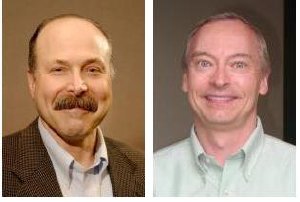May 3 2010
A team of scientists at UC Santa Barbara that helped pioneer research into the quantum properties of a small defect found in diamonds has now used cutting-edge computational techniques to produce a road map for studying defects in alternative materials.
Their new research is published in the online edition of the Proceedings of the National Academy of Sciences (PNAS), and will soon be published in the print edition of the journal. The findings may enable new applications for semiconductors --materials that are the foundation of today's information technology. In particular, they may help identify alternative materials to use for building a potential quantum computer.
 (left) David Awschalom (Credit: Rod Rolle). (right) Chris Van de Walle (Credit: George Foulsham, Office of Public Affairs, UCSB)
(left) David Awschalom (Credit: Rod Rolle). (right) Chris Van de Walle (Credit: George Foulsham, Office of Public Affairs, UCSB)
"Our results are likely to have an impact on experimental and theoretical research in diverse areas of science and technology, including semiconductor physics, materials science, magnetism, and quantum device engineering," said David D. Awschalom, UCSB physics professor and one of two lead investigators on this project. "Ironically, while much of semiconductor technology is devoted to eliminating the defects that interfere with how today's devices operate, these defects may actually be useful for future quantum technologies."
According to PNAS, the researchers have developed a set of screening criteria to find specific atomic defects in solids that could act as quantum bits (qubits) in a potential quantum computer. As a point of reference, they use a system whose quantum properties they themselves have recently helped to discern, the NV or nitrogen-vacancy center defect in diamond. This defect, which the team has shown can act as a very fast and stable qubit at room temperature, consists of a stray nitrogen atom alongside a vacancy in the otherwise perfect stacking of carbon atoms in a diamond.
Electrons trapped at the defect's center interact with light and microwaves in a predictable way, allowing information to be stored in and read out from the orientation of their quantum-mechanical spins.
The drawback to using diamond, however, is that the material is expensive and difficult to grow and process into chips. This raises the question of whether there may be defects in other materials that have similar properties and could perform equally well.
In this week's publication, the researchers enumerate specific screening criteria to identify appropriate defects in materials that could be useful for building a quantum computer. Experimental testing of all the potential candidates might take decades of painstaking research, explained Awschalom. To address this problem, the UCSB group employed advanced computational methods to theoretically examine the characteristics of potential defect centers in many different materials, providing a sort of road map for future experiments.
UCSB's Chris G. Van de Walle, professor of materials and one of the senior investigators on the project, remarked: "We tap into the expertise that we have accumulated over the years while examining 'bad' defects, and channel it productively into designing 'good' defects; i.e., those that have the necessary characteristics to equal or even outperform the NV center in diamond." This expertise is backed up by advanced theoretical and computational models that enable the reliable prediction of the properties of defects, a number of which are proposed and examined in the paper.
Awschalom added: "We anticipate this work will stimulate additional collaborative activities among theoretical physicists and materials engineers to accelerate progress towards quantum computing based on semiconductors."
Current computers are based on binary logic: each bit can be either "one" or "zero." In contrast, each qubit in a quantum computer is continuously variable between these two states and hence offers infinitely more possibilities to be manipulated and combined with other qubits to produce a desired computational result. "It has been well established that, in theory, quantum computers can tackle some tasks that are completely beyond the capabilities of binary computers," said Awschalom. "The challenge has been to identify real physical systems that can serve as qubits for future machines."
Source: http://www.ucsb.edu/